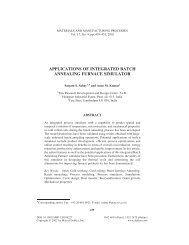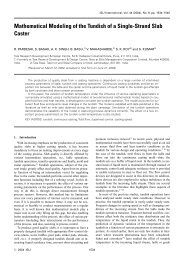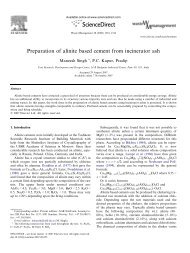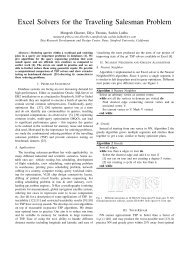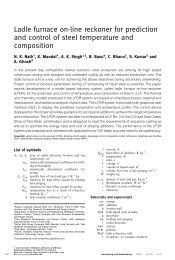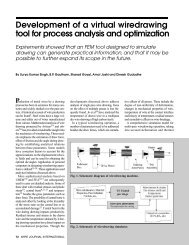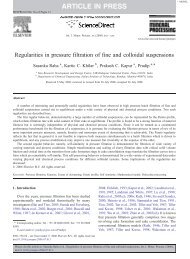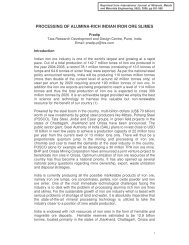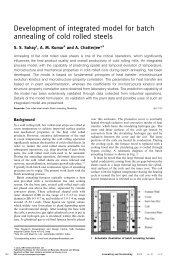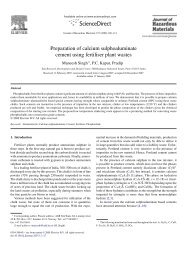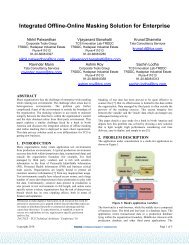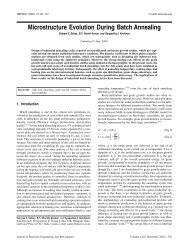RIPSAC - TRDDC
RIPSAC - TRDDC
RIPSAC - TRDDC
You also want an ePaper? Increase the reach of your titles
YUMPU automatically turns print PDFs into web optimized ePapers that Google loves.
<strong>RIPSAC</strong> - A PaaS platform for IoT<br />
Applications<br />
Prateep Misra<br />
(prateep.misra@tcs.com)<br />
TCS Innovation Labs<br />
Dated : 11 Jan 2012<br />
Copyright © 2011 Tata Consultancy Services<br />
Limited<br />
1
Agenda<br />
<br />
<br />
<br />
<br />
<br />
<br />
Introducing <strong>RIPSAC</strong><br />
Key Concepts in Physical Web<br />
Sensor Web Enablement<br />
<strong>RIPSAC</strong> PaaS Platform<br />
<strong>RIPSAC</strong> Applications<br />
Related Research Projects<br />
2
TCS <strong>RIPSAC</strong> Platform<br />
<strong>RIPSAC</strong> – Real-time Integrated<br />
Platform for Services & Analytics in<br />
Cars / Cities<br />
3
TRANSPORT<br />
4<br />
<strong>RIPSAC</strong> Context<br />
BANKING<br />
INSURANCE<br />
AGRICULTURE<br />
HEALTHCARE<br />
GOVERNMENT<br />
UTILITY<br />
MANUFACTURI<br />
NG<br />
APPLICATION SERVICES<br />
INFRASTRUCTURE PLATFORM<br />
INTERNET<br />
GATEWAY<br />
ACTUATE<br />
ANALYZE<br />
SENSE
<strong>RIPSAC</strong> Overview<br />
<strong>RIPSAC</strong> Visualization<br />
<strong>RIPSAC</strong> Backend<br />
Server & database<br />
Aggregate<br />
Analytics<br />
Internet<br />
<strong>RIPSAC</strong> Gateway Device /<br />
<strong>RIPSAC</strong> App on Smart Phones<br />
Sensor Networks<br />
GSM/GPRS, 3G<br />
USB, CAN, Zigbee, BT,<br />
NFC, WiFi<br />
Proxy +<br />
Localized<br />
Analytics<br />
Sense<br />
In Vehicle Sensors<br />
(GPS, Accel, Compass, Audio , camera, Car OBD, other after market)<br />
5
Integrated Platform for Intelligent Infrastructure<br />
Intelligence<br />
Detect gas leakage/water contamination :<br />
mobilize rescue team, suggest optimum route<br />
Divert Road Traffic in case of<br />
Water Pipeline Burst<br />
Correlate Electricity/Water<br />
/Gas consumption patterns<br />
Integrated Intelligent Smart Integrated Services Services<br />
Respond<br />
Transportation Healthcare Electricity<br />
Community<br />
Analyze<br />
Public Safety<br />
Integrated Services<br />
Tourism<br />
Water<br />
Smart Domain Services<br />
etc.<br />
Extract<br />
Intelligent Smart Integration Platform<br />
Sense<br />
Sensors & IoT<br />
Platform (<strong>RIPSAC</strong>)<br />
Traditional Monitoring & Control<br />
Systems<br />
Citizen Data<br />
Social Media<br />
Sense: People Activity, Appliances, Vehicles , Road, Home/Bldg., Utility<br />
Infrastructure<br />
People Feedback & Emotions<br />
6
Agenda<br />
<br />
<br />
<br />
<br />
<br />
<br />
Introducing <strong>RIPSAC</strong><br />
Key Concepts in Physical Web<br />
Sensor Web Enablement<br />
<strong>RIPSAC</strong> PaaS Platform<br />
<strong>RIPSAC</strong> Applications<br />
Research Components<br />
7
Physical Web Concepts<br />
Sensor Web – Integrating and accessing sensors<br />
and devices to the Web using standard WWW<br />
protocols<br />
MCS – Mobile Crowdsensing / Community<br />
Sensing / Participatory Sensing<br />
M2M – Automated data transmission and<br />
measurement between devices with no human in<br />
the path<br />
IoT - World wide network of heterogeneous smart<br />
objects using standard communication protocols<br />
8
What are Sensors and why they are important<br />
<br />
<br />
<br />
Sensors<br />
– Software or hardware artifact which are able to observe people,<br />
places, things, phenomena<br />
Sensor Node<br />
– A device that has sensors, CPU and a communication module<br />
Sensors & Actuators<br />
– Enable new information to be created without human data entry<br />
– Provide infrastructure for monitoring and interacting with real-world<br />
entities, enable Real-world Awareness<br />
– Bridge the real-world and the digital world<br />
9
Sensor Networks & Sensor Web<br />
<br />
<br />
Sensor Networks focus on<br />
– Motes / low power, resource constrained devices<br />
– Tiny operating systems, low power network protocols, low power<br />
data storage<br />
– Directed diffusion<br />
– Sensor Proxies, Query Processing on Streams<br />
Sensor Web : Sensor Network that has<br />
– Global scale<br />
– Intelligent, resourceful nodes<br />
– High bit rate sensor feeds<br />
– Supports multiple diverse services<br />
10
Why we need Sensor Web<br />
<br />
<br />
Traditional Sensor Networks<br />
– Sensors Locked in Unimodal Closed Systems<br />
– Sensor World & Web World are disconnected<br />
– Need human in the loop<br />
Sensor Web<br />
– Connect Sensors to web – help find relevant information by<br />
directly accessing sensor data<br />
– Enable discovery, search and sophisticated querying<br />
– Integrate sensor data with other web resources<br />
– Publish outputs in machine readable formats, use open interfaces<br />
and data formats<br />
– Provide large scale controlled access<br />
– Allow annotations with machine understandable semantic metadata<br />
– further automation, intelligence and interoperability<br />
11
Sensor Web Design Requirements<br />
<br />
<br />
<br />
<br />
<br />
<br />
<br />
<br />
Manage Scale – Planet wide device deployment, management,<br />
data collection and storage<br />
Managing heterogeneity, change, evolution,<br />
Real-time adaptation of data collection and processing<br />
Single view of the network, high level query support<br />
Ubiquitous information access<br />
Authorization, Access Controls, Integrity & Privacy<br />
Robustness<br />
Enable creation of new services on common shared pool of<br />
sensors<br />
12
Data Collection Challenges in Sensor Webs<br />
<br />
<br />
Multiple services share a common set of sensor nodes and<br />
feeds<br />
– Multi tenancy in sensors<br />
– Resource allocation challenges<br />
– Security<br />
– Privacy<br />
Managing data volumes, overloaded network and storage<br />
– Need filtering / extraction at the source or close to the source<br />
13
Data Query Challenges<br />
<br />
Observation databases for different services may be very<br />
different from each other<br />
– E.g. video surveillance vs. health monitoring database<br />
<br />
Widely different query patterns<br />
<br />
Widely different temporal coherence and end-to-end delay<br />
requirements<br />
<br />
Varying but high update rates<br />
– How do you partition ( and distribute) the database to support high<br />
update rates yet provide rich query support and performance<br />
14
Local Analytics<br />
<br />
<br />
<br />
<br />
Processing of raw sensor observation in-Situ<br />
Why<br />
– Energy & Bandwidth optimization<br />
– Reducing load at backend<br />
Context Inference<br />
Application specific algorithms and heuristics<br />
15
Aggregate Analytics<br />
Analyzing data from many sensors / devices<br />
Identify spatio temporal patterns<br />
Real-world entities are interesting / useful when considered<br />
together as part of a larger system/group<br />
Modeling real world phenomena – how they evolve spatially<br />
and temporally<br />
Pattern detection<br />
Sensor Data Fusion / Centralized<br />
Classifier Combination / Multi Stage Classification /<br />
16
Related Work<br />
Project Who & When Contribution<br />
Cooltown HP Labs, 2001 Web based ubiquitous computing<br />
IrisNet<br />
Intel Research & CMU<br />
, 2003<br />
World wide sensor web design<br />
CarTel MIT CSAIL , 2007 Vehicular cyber-physical system<br />
CitySense Harvard, 2007 Urban scale wireless sensor network testbed<br />
WikiCity<br />
MIT Senseable City<br />
Real-time urban dynamics ( “Real Time Rome”)<br />
Lab, 2007<br />
Nericell<br />
UBI<br />
Microsoft Research,<br />
2008<br />
Univ of Oulu, Finland,<br />
2009<br />
Road and Traffic Condition monitoring using<br />
Mobile Crowdsensing<br />
Open Urban Computing testbed<br />
Sensor Web 52 North, Germany OGC SWE reference implementation<br />
Spitfire EU Project Architecture for semantic applications involving<br />
Internet connected sensors<br />
17
Agenda<br />
<br />
<br />
<br />
<br />
<br />
<br />
Introducing <strong>RIPSAC</strong><br />
Key Concepts in Physical Web<br />
Sensor Web Enablement<br />
<strong>RIPSAC</strong> PaaS Platform<br />
<strong>RIPSAC</strong> Applications<br />
Research Components<br />
18
OGC Sensor Web Enablement<br />
<br />
<br />
Web Services and Encodings framework from Open Geospatial<br />
Consortium<br />
– Interface specifications<br />
– Schema definitions<br />
OGC SWE Services Interface Specification and Schemas for<br />
– Sensor Description model language ( SensorML) for sensor description<br />
and discovery<br />
– Observations & Measurement schema ( O&M Schema) for encoding<br />
observations and results<br />
– Sensor Observation Query and Transaction services ( SOS)<br />
– Sensor alerts / events publishing & subscription services ( SES)<br />
– User driven acquisitions and observations - Sensor Planning & Tasking (<br />
SPS)<br />
– Asynchronous delivery of messages and alerts - Web Notification Service<br />
( WNS)<br />
19
Sensor Web Enablement Operations Cycle<br />
20
Sensor services<br />
Sensor Observation Service(SOS)<br />
<br />
<br />
<br />
Provides access to observations for heterogeneous sensor systems.<br />
Horizontal model since it applies to all domains that use sensors to<br />
collect data.<br />
Spatio-temporal query support<br />
Sensor Event Service(SES)<br />
<br />
<br />
<br />
<br />
Provides publish subscribe based service on different events<br />
exchange between producer and consumer.<br />
Provides registration and publishing of event service.<br />
Provides subscribe service and subsequently notification of service.<br />
Provides subscribe/unsubscribe of choice able events trough different<br />
filtration mechanism.<br />
21
Sensor services<br />
Sensor Planning Service<br />
• Control sensors and provides operations for task management in<br />
Sensor.<br />
• Checks feasibility ,define , submit a task in sensor<br />
• Provides getStatus, update or modify , cancellation of an running<br />
task.<br />
• Uses WNS to communicate Client in asynchronous manner<br />
• New task created via SPS would subsequently is a service of SOS<br />
Web Notification Service (WNS)<br />
• Provides standard web service interface for asynchronous delivery of<br />
messages or alerts<br />
• The SES either sends the alert directly to the client, or makes use of<br />
the WNS in order to deliver the alert message<br />
22
SOS & O&M Interactions<br />
SensorML<br />
Sensors Register<br />
Publish SOS<br />
Register<br />
Register<br />
Bind<br />
Catalog Service<br />
Search<br />
SOS instances<br />
DB<br />
O & M<br />
23
SPS, WNS & Asynchronous Notifications<br />
SensorML<br />
Sensors Register<br />
Publish SOS<br />
Task<br />
Register<br />
Register<br />
Get Result<br />
O & M<br />
Catalog Service<br />
Search<br />
SOS instances<br />
SPS<br />
Task<br />
Notify<br />
WNS<br />
Notification<br />
24
O & M Schema<br />
25
SOS – Simple Query<br />
<br />
<br />
GAUGE_HEIGHT<br />
urn:ogc:def:phenomenon:OGC:1.0.30:waterlevel<br />
text/xml;subtype="om/1.0.0"<br />
<br />
26
SOS : Spatio-Temporal Query<br />
GAUGE_HEIGHT<br />
<br />
<br />
om:samplingTime<br />
<br />
2011-10-<br />
01T17:44:15+00:00<br />
2011-12-<br />
31T17:44:15+00:00<br />
<br />
<br />
<br />
urn:ogc:object:feature:Sensor:IFGI:ifgisensor-1<br />
urn:ogc:def:phenomenon:O<br />
GC:1.0.30:waterlevel<br />
<br />
<br />
urn:ogc:data:location<br />
<br />
50.0<br />
7.0<br />
53.0<br />
10.0<br />
<br />
<br />
<br />
<br />
<br />
urn:ogc:def:phenomenon:<br />
OGC:1.0.30:waterlevel<br />
5<br />
<br />
<br />
27
Agenda<br />
<br />
<br />
<br />
<br />
<br />
<br />
Introducing <strong>RIPSAC</strong><br />
Key Concepts in Physical Web<br />
Sensor Web Enablement<br />
<strong>RIPSAC</strong> PaaS Platform<br />
<strong>RIPSAC</strong> Applications<br />
Research Components<br />
28
<strong>RIPSAC</strong><br />
<strong>RIPSAC</strong> Revisited<br />
– is a PaaS<br />
– is designed for Sensor Web & Mobile Crowdsensing<br />
apps<br />
– is based on OGC SWE standards<br />
29
<strong>RIPSAC</strong> Deployed Components<br />
<br />
<strong>RIPSAC</strong> Edge Device (ED) – A gateway device or mobile device<br />
<br />
<strong>RIPSAC</strong> Edge Application (EA) instance –An application program instance<br />
that runs on a given ED<br />
<br />
<strong>RIPSAC</strong> Edge Service (ES) instance –A set of <strong>RIPSAC</strong> services that runs on<br />
a given ED<br />
<strong>RIPSAC</strong> Cloud Application (CA / CS) instance - A backend application /<br />
service that serves one or more EAs / ES.<br />
<br />
<strong>RIPSAC</strong> Cloud Platform (CP) instance– A set of services together with the<br />
supporting software infrastructure that provides <strong>RIPSAC</strong> core services.<br />
Accessed via APIs from the EAs and CAs<br />
<br />
<strong>RIPSAC</strong> Cloud Execution resource (CER) – A set of physical or virtual<br />
machines that run one or more CA instance and/or one or more CP instances<br />
30
<strong>RIPSAC</strong> Deployments<br />
ED1<br />
CP1<br />
ED2<br />
EA<br />
EA<br />
Internet<br />
Internet<br />
CP2<br />
CA<br />
CA<br />
CS<br />
CS<br />
Internet<br />
EDn<br />
ES<br />
EDm<br />
ES<br />
Large number of Edge Devices<br />
CPn<br />
CA<br />
CS<br />
Multiple Platform Instances<br />
31
<strong>RIPSAC</strong> Interfaces<br />
<strong>RIPSAC</strong> will enable apps and services to interface with<br />
<br />
<br />
<br />
<br />
Virtually unlimited set of sensors, actuators and devices placed<br />
within a automobile<br />
Other <strong>RIPSAC</strong> apps and services<br />
Networked apps and data resident in a cloud<br />
Any available web resources<br />
32
Platform-as-a-Service<br />
Definition<br />
– capability provided to the consumer is to<br />
deploy onto the cloud infrastructure consumer<br />
created or acquired applications created using<br />
programming languages and tools supported<br />
by the provider<br />
– consumer does not manage or control the<br />
underlying cloud infrastructure<br />
33
<strong>RIPSAC</strong> PaaS Cloud Use Case<br />
<strong>RIPSAC</strong><br />
Internet<br />
Analytics<br />
App Developers<br />
Sensor<br />
Services<br />
Storage<br />
Services<br />
Sensors<br />
Internet<br />
PaaS Provider<br />
Sensor Providers<br />
End User<br />
34
<strong>RIPSAC</strong> Actors<br />
Sensor Providers<br />
– Public Sector / Local Government / City Departments<br />
– Private Organization / Community<br />
– Citizens<br />
Application Providers<br />
– Subscriber Community, Public<br />
– TCS delivery teams, TCS customers<br />
PaaS Provider<br />
– TCS<br />
– TCS Customer – e.g. Smart City governments<br />
35
Architectural Requirements<br />
<strong>RIPSAC</strong> architecture is designed to support<br />
<br />
<br />
<br />
<br />
<br />
Heterogeneous sensors and device integration<br />
Distributing computation and storage on edge as well as cloud<br />
Frugally engineered – reduce redundancies while enabling<br />
scalability<br />
Enabling end user to control privacy settings while respecting<br />
end-user license agreements<br />
Ease of development and deployment of certified apps and<br />
services by third parties<br />
36
<strong>RIPSAC</strong> Platform APIs / SDKs / Tools<br />
<br />
Platform Provider<br />
– Core IoT Serivces<br />
– Identity , Security, Privacy<br />
– End User License Mgmnt<br />
– Ad Delivery<br />
– Multi-tenancy<br />
– Sandboxes<br />
– Operation Support Systems<br />
App Developer End User<br />
– Dev & Test Sandboxes<br />
– SDK & APIs<br />
– Test Data<br />
– Publish Apps<br />
– Define EULAs<br />
– Manage App Life Cycle<br />
<br />
Sensor Provider<br />
– Feature, Phenomena & Sensor<br />
description<br />
– Define feeds & sensor streams<br />
– Publish & share sensor streams<br />
– Define access control and privacy<br />
preferences<br />
– Download Apps<br />
– Subscribe / Unsubscribe Services<br />
– Control Privacy Settings<br />
– View usage history, billing etc.<br />
37
Current PaaS offerings<br />
Feature Options Examples<br />
Deployment model Hosted GAE, Azure, Heroku<br />
Control of<br />
infrastructure<br />
Build your own using<br />
Private / Open Source<br />
Add on to IaaS<br />
No control<br />
Control via IaaS<br />
Full control<br />
CumuLogic, CloudFoundry,<br />
RedHat CloudForms<br />
AWS BeanStalk<br />
GAE<br />
AWS<br />
All private PaaS<br />
Language Support Java / Multi GAE, CloudFoundry,<br />
CumuLogic, CloudForms,<br />
BeanStalk, CloudBees etc.<br />
Others – e.g. Ruby,<br />
Scala, PHP, Node.js<br />
Heroku, Zend<br />
SDK & Frameworks Standard Cumulogic<br />
Proprietary<br />
GAE<br />
38
What Current PaaS Offerings Provide<br />
<br />
<br />
Core Services<br />
– Web and Application Containers<br />
– App Instances / Workers<br />
– Data Storage – Relational , NoSQL, Document, Blob<br />
– Queue Services<br />
– Etc.<br />
Non Functional<br />
– Development support<br />
– Deployment support<br />
– Secure Sandbox & Multi-tenancy, Metering<br />
– Auto Scaling<br />
– Load balancing<br />
– Etc.<br />
39
Current PaaS platforms are inadequate<br />
<br />
Good support for<br />
– Web Apps<br />
– Big Data, Databases, Messaging, Queues<br />
<br />
Inadequate / missing<br />
– Support for sensor devices , observations, alerts, notifications<br />
– Support for messaging in constrained devices<br />
– Real-time analytics / Stream Processing, reasoning<br />
40
What is needed in the PaaS<br />
Platform Services<br />
Applications<br />
APIs<br />
Analytics<br />
Infrastructure<br />
Service APIs, User Management,<br />
Privacy , Authentication,<br />
Authorization, Access Controls,<br />
Quotas / Limits, Metering<br />
Statistical packages, Machine<br />
Learning Libraries, Rule Engines,<br />
CEP Engines, Reasoners,<br />
Planners,<br />
Device Services, Sensor Data<br />
Services, GIS, Event Services,<br />
Analytics Services<br />
Core Platform<br />
Web Servers, App Servers,<br />
Service Bus, Service<br />
Orchestration, Messaging<br />
Middleware,<br />
Databases, NOSQL, Data<br />
Warehouses, File Systems ,<br />
Cluster FS<br />
41
Design Options<br />
<br />
<br />
Hosted PaaS<br />
– Core platform on hosted PaaS<br />
– IoT Platform Services and Analytics developed and deployed on<br />
IaaS ( AWS EC2, EBS, S3, etc. )<br />
– Integration via Web Services<br />
Private PaaS<br />
– Private infrastructure cloud<br />
– Core Platform based on private Java PaaS & open frameworks<br />
and deployed on above infrastructure cloud<br />
– Custom developed IoT Platform Services<br />
– Open Source Analytics Infrastructure<br />
– Integration via RMI or Web Services<br />
42
<strong>RIPSAC</strong> backend platform realization<br />
Application Servers<br />
( Play Framework +<br />
Apache Tomcat)<br />
Application Server<br />
( Apache Tomcat)<br />
Service Proxies<br />
REST , CoAP, MQTT bridge<br />
ObjectStore<br />
S3<br />
PostGres +<br />
PostGIS<br />
JPA, JDO,<br />
JDBC<br />
<strong>RIPSAC</strong> Integration Bus ( Apache Synapse)<br />
Application<br />
Server ( Apache<br />
Tomcat)<br />
<strong>RIPSAC</strong> Services<br />
( Apache Tomcat)<br />
SWE Services<br />
Intelligent Services<br />
Identity Server<br />
OpenId provider<br />
XACML<br />
SAML<br />
CEP<br />
( Drools,<br />
Esper)<br />
43
Agenda<br />
<br />
<br />
<br />
<br />
<br />
<br />
Introducing <strong>RIPSAC</strong><br />
Key Concepts in Physical Web<br />
Sensor Web Enablement<br />
<strong>RIPSAC</strong> PaaS Platform<br />
<strong>RIPSAC</strong> Applications<br />
Research Components<br />
44
Example Applications on <strong>RIPSAC</strong><br />
<br />
<br />
<br />
<br />
<br />
<br />
<br />
Smart remote healthcare<br />
Unmanned level crossing<br />
Participatory value-added apps for vehicle owners like “Findmy-Carpool-Buddy”.<br />
“Share-a-Ride” etc.<br />
Targeted advertising delivery to car occupants based on<br />
learned behavior<br />
Infrastructure monitoring – e.g. Road Condition monitoring<br />
Environmental monitoring – City sound scaping<br />
Safe City - Large scale video surveillance<br />
45
<strong>RIPSAC</strong> Application – Road Condition Monitoring<br />
Use Case<br />
• Monitor road conditions using participatory<br />
sensing<br />
Technology<br />
Sense<br />
• Accelerometer in the Smart Phone in Car<br />
Extract<br />
• Phone-orientation Correction<br />
• Vehicular Noise Cancellation<br />
• Feature Extraction<br />
• Anomaly Detection<br />
Analyze<br />
• Learning-based Classification<br />
• Multi-user Fusion<br />
Respond<br />
• Road Condition Map to municipal authority<br />
• Pothole alert to end-user<br />
• Driving Behavior to Insurance Company<br />
• Road Condition and Driving Behavior assisted<br />
Car Prognosis to Automotive Manufacturer<br />
46
Road Condition Monitoring : O&M Schema<br />
47
Road Condition Monitoring : Data Insertion Sequence<br />
48
<strong>RIPSAC</strong> Application - Smart Healthcare @ Home<br />
ECG<br />
433 Mhz RF UDP<br />
Gateway<br />
Proxy<br />
Portal<br />
Pulse Oxymeter<br />
REST APIs<br />
<strong>RIPSAC</strong><br />
BP Monitor<br />
Bluetooth<br />
Android Phone<br />
Fat Analyzer<br />
49
Remote Healthcare : O&M Schema<br />
50
<strong>RIPSAC</strong> Application : SMS Based Alert for<br />
Unmanned Level Crossing<br />
51
<strong>RIPSAC</strong> Application : Video Surveillance<br />
<br />
<br />
<br />
Overview<br />
Scalable petabytes of<br />
data<br />
Standard interfaces<br />
API for media<br />
receiving/recording<br />
and queries<br />
Live View<br />
Camera Controls,<br />
Camera Receiving<br />
TCS NVR<br />
Event in XML,<br />
Video<br />
Live View<br />
N<br />
V<br />
D<br />
Internet /<br />
WAN<br />
Camera Controls,<br />
Camera Receiving<br />
NVT<br />
RTSP URI<br />
Video/Audio Track<br />
& Metadata –<br />
Camera ID, Loc,<br />
Tilt/Pan<br />
NVT<br />
Receiving<br />
NVA<br />
NVS<br />
Receiving<br />
RTSP URI<br />
Video/Audio Track &<br />
Metadata – Event XML<br />
SES<br />
<br />
Platform for video<br />
analytics. Interfaces<br />
for uploading<br />
analytics algorithms<br />
and choosing<br />
datasets<br />
NVR – Network Video Recorder<br />
NVD – Network Video Display<br />
NVT – Network Video Transmitter<br />
NVA- Network Video Analyzer<br />
NVS – Network Video Storage<br />
TCS NVR Interface<br />
ONVIF 1.2 Interface<br />
NVT/NVA<br />
SOS<br />
Geospatial DB, Key value Store<br />
Stored Event Viewer<br />
ONVIF 2.0 Interface<br />
NVT/NVA<br />
Device Management, Device Discovery<br />
Recording, Receiving<br />
Query<br />
Network Video Storage<br />
BLOB Store<br />
Object Store<br />
Other standard<br />
Interface like PISA<br />
Server & Storage Farm<br />
Live Event Subscriber<br />
52
Agenda<br />
<br />
<br />
<br />
<br />
<br />
<br />
Introducing <strong>RIPSAC</strong><br />
Key Concepts in Physical Web<br />
Sensor Web Enablement<br />
<strong>RIPSAC</strong> PaaS Platform<br />
<strong>RIPSAC</strong> Applications<br />
Related Research Projects<br />
53
ParTS ( Participative Traffic Surveillance )<br />
Presence<br />
Detection<br />
BTS<br />
location<br />
BTS<br />
Network<br />
Server<br />
•Authentication<br />
•Vehicle Reputation<br />
•Trustworthiness<br />
•Privacy Protection<br />
•Metric based Analytics,<br />
Reports<br />
Surveillance<br />
Camera<br />
Image/video ( embedded<br />
with meta data using<br />
steganography)<br />
Number Plate, GPS,<br />
Orientation, Ambient<br />
Light,Sound,Speed,<br />
Timestamp, Nature of<br />
violation<br />
Insurance Traffic Dept Citizen<br />
Premium<br />
Discounts<br />
Penalty Charging,<br />
Awareness Training,<br />
Regulations,<br />
Planning<br />
Award<br />
Points,<br />
Road<br />
Safety<br />
Alerts,<br />
Used car<br />
info<br />
54
Mobile Phone based OCR, Contour Marching and<br />
Speech Processing<br />
Use Case<br />
Automated Car Insurance Claim Registration<br />
• VIN number detection from mobile phones<br />
• Vehicle damage detection from mobile<br />
phones<br />
Sensors<br />
• Mobile phone camera and microphone<br />
Research Problem<br />
• OCR Pre-processing and low power OCR<br />
• Contour matching<br />
• Speech processing for speaker identification / VIN correction<br />
55
Ultrasound based Localization on Mobile Phones<br />
Use Case<br />
• Ultrasound beacon transmission in the store and<br />
location decoding by app on mobile<br />
• User presence for Loyalty Apps<br />
• Rack Location based Promotion<br />
• Buying and Checking out without Cashier Intervention<br />
Sensors<br />
• Microphone in Smart Phone<br />
• Camera in Smart Phone<br />
Research Problem<br />
• Two-way ultrasound communication with high<br />
range and low response time<br />
56
People Counting using Image Processing<br />
Use Case<br />
• IR LEDs and IR cameras are used to<br />
count number of people in front of the<br />
television - used to generate the TV<br />
program viewership data<br />
Details<br />
• Two webcams spaced apart by 1 ft giving<br />
overlapping viewing coverage<br />
• Pair of IR LEDs are placed close to each<br />
camera<br />
• Face Detection, Body Posture Detection<br />
and Background Modeling are combined<br />
to improve the detection above 92 %<br />
from 75 to 80%<br />
Research Problem<br />
• Multi-algorithm fusion to improve<br />
detection probability<br />
57
Further Reading<br />
1. IrisNet: An Architecture for a Worldwide Sensor Web, Philip B. Gibbons, et.al,<br />
October 2003 IEEE Pervasive Computing , Volume 2 Issue 4<br />
2. OGC Sensor Web Enablement Architecture, Open Geospatial Consortium,<br />
December 2008<br />
3. Using Google App Engine, Charles Severance, O Reilly | Google Press, May<br />
2009<br />
4. Participatory Sensing: Applications and Architecture, Deborah Estrin ,<br />
January/February 2010, IEEE Internet Computing<br />
5. The Internet of Things, Michael Chui, et.al, McKinsey Quarterly 2010,<br />
Number 2<br />
6. Semantic Sensor Network XG Final Report, W3C Incubator Group Report 28,<br />
June 2011<br />
7. SPITFIRE: Towards a Semantic Web of Things, Dennis Pfisterer et.al,<br />
November 2011, IEEE Communication Magazine,<br />
58
Thank You<br />
Email : Prateep.Misra@tcs.com<br />
59



